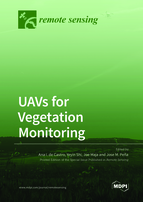UAVs for Vegetation Monitoring
A special issue of Remote Sensing (ISSN 2072-4292). This special issue belongs to the section "Remote Sensing in Agriculture and Vegetation".
Deadline for manuscript submissions: closed (31 March 2021) | Viewed by 140135
Special Issue Editors
Interests: remote sensing; crop monitoring; precision agriculture; weeds; plant disease; crop phenotyping; site-specific weed management; object-based image analysis (OBIA)
Interests: remote sensing; UAVs; data analysis; machine learning; abiotic and biotic stress monitoring and management
Interests: precision agriculture; UAV and satellite remote sensing; object-based image analysis (OBIA); digitization and sensors in agriculture; crop protection; weed mapping; sustainable agriculture
Special Issues, Collections and Topics in MDPI journals
Special Issue Information
Dear Colleagues,
Global crop production faces a major challenge regarding sustainability in the context of a rapidly growing world population and the gradual diminishing of natural resources. Remote sensing plays a fundamental role in changing the plant production model through the development of new technologies (robots, UAVs, sensors), making products more profitable and competitive and, also, more sustainable. Among the new advances, unmanned aerial vehicles (UAVs) equipped with perception systems have demonstrated suitability in the timely assessment and monitoring of vegetation. They can be operated at low altitudes, providing an ultra-high spatial resolution image, have great flexibility of flight scheduling for data collection at critical and desired moments and, also, the generation of digital surface models (DSMs) using highly overlapped images and photo-reconstruction techniques or artificial vision. Therefore, it is essential to advance the research for the technical configuration of UAVs, as well as to improve processing and analyzing of the UAV imagery of agricultural and forest scenarios in order to strengthen the knowledge of ecosystems and thereby improve farmers’ decision-making processes.
We encourage all members involved in the development and applications of UAVs to show their most recent findings focused on promising developments related to vegetation monitoring. This Special Issue welcomes original and innovative papers demonstrating the use of UAVs for remote sensing applications in the areas of agricultural, forestry, and natural resources managements. The selection of papers for publication will depend on quality and rigor of the research and paper. Specific topics include, but are not limited to:
- UAV configuration and specifications for forest or agricultural applications;
- Object- or pixel-based image analysis approaches for vegetation monitoring;
- Artificial intelligence-based image-processing approaches;
- Integration of UAV images with ground-based dataset or other remote and proximal measurements;
- Biotic (weeds, disease) and abiotic (water, nutrition deficiencies) stress factors—sensing and modeling;
- Crop yield estimation or prediction;
- High-throughput phenotyping;
- UAV-based prescription map development for site-specific management;
- Precision agriculture applications;
- UAV image pre-processing for radiometric, spectral and spatial calibration, and mosaicking;
- Development, integration, and testing of new and emerging sensors and technologies for UAV-based crop management.
Dr. Ana de Castro Megías
Dr. Yeyin Shi
Dr. José M. Peña
Prof. Dr. Joe Maja
Guest Editors
Manuscript Submission Information
Manuscripts should be submitted online at www.mdpi.com by registering and logging in to this website. Once you are registered, click here to go to the submission form. Manuscripts can be submitted until the deadline. All submissions that pass pre-check are peer-reviewed. Accepted papers will be published continuously in the journal (as soon as accepted) and will be listed together on the special issue website. Research articles, review articles as well as short communications are invited. For planned papers, a title and short abstract (about 100 words) can be sent to the Editorial Office for announcement on this website.
Submitted manuscripts should not have been published previously, nor be under consideration for publication elsewhere (except conference proceedings papers). All manuscripts are thoroughly refereed through a single-blind peer-review process. A guide for authors and other relevant information for submission of manuscripts is available on the Instructions for Authors page. Remote Sensing is an international peer-reviewed open access semimonthly journal published by MDPI.
Please visit the Instructions for Authors page before submitting a manuscript. The Article Processing Charge (APC) for publication in this open access journal is 2700 CHF (Swiss Francs). Submitted papers should be well formatted and use good English. Authors may use MDPI's English editing service prior to publication or during author revisions.
Keywords
- UAV
- crop mapping
- image analysis
- multispectral
- hyperspectral
- thermal
- reflectance
- classification
- digital surface model
- precision agriculture









